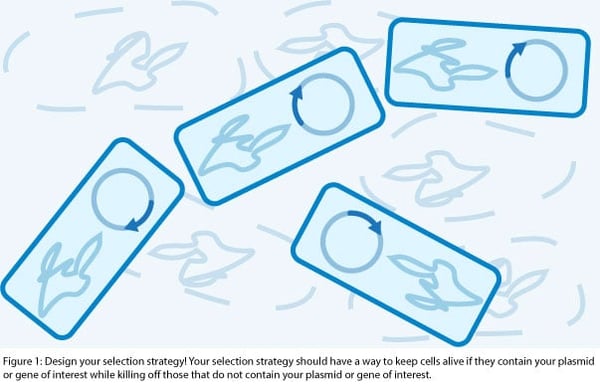You’ve worked hard to purify your gene of interest, get it into your plasmid backbone, and zap the mixture of DNA into cells. Unfortunately, not every cell successfully takes up plasmid DNA. Among those that do, some now have plasmids that contain your gene of interest, but others will uptake plasmid backbones that re-ligated back on themselves.
Therefore, your cloning strategy needs to identify cells containing the plasmid construct you’re seeking. Fortunately, there are many ways to do this involving positive selection, negative selection, and/or screening. We’re focusing on positive and negative selection in this blog post, but don’t worry, we’ll cover screens in a future post.

Positive selection: Cells that have gained a specific gene survive
In positive selection, only cells that contain a specific gene survive. The rest do not grow. While there are many ways to design your positive selection strategy, here are a few to consider.
Antibiotic selection
Selection is straightforward in cases where the inserted DNA includes an antibiotic resistance marker. After transformation, plate the cells on medium containing the corresponding antibiotic. For example, if the DNA you’re inserting into the plasmid backbone contains a kanamycin resistance cassette, you would plate the cells on kanamycin-containing agar. Only cells carrying plasmids that contain a kanamycin resistance cassette will grow.
However, often times, the plasmid backbone includes an antibiotic resistance cassette and you aren’t introducing an additional antibiotic resistance cassette along with your gene of interest. In these cases, antibiotic selection will select for cells that have been transformed with the plasmid backbone (with or without your inserted DNA) and further screening will help you determine if the plasmid backbone contains your gene of interest.
Auxotrophy
Besides antibiotic selection, you can select for a successful uptake of your DNA of interest by taking advantage of bacterial characteristics such as prototrophy, the ability to synthetize all compounds needed for growth, or auxotrophy, the inability to synthesize a compound needed to grow.
Auxotrophy and prototrophy come into play during cloning if you’ve designed your experiment using an auxotrophic strain of bacteria (one that doesn’t synthesize an essential amino acid), and a plasmid that complements the auxotrophy (i.e., synthesizes the critical amino acid). Many common E. coli strains used for cloning are auxotrophic for specific amino acids. When plated on media lacking the essential amino acid, the bacteria will only grow if it acquired the plasmid containing the gene necessary to synthesize the missing amino acid.
Auxotrophic selection is often used for cloning in yeast since antibiotic resistance spontaneously arises in yeast. For example, Markus Ralser’s lab created a yeast prototrophy kit containing 23 plasmids to complement auxotrophy.
Negative selection: Cells that have lost a specific gene survive
Unlike positive selection, negative selection means you’re selecting for the loss of a gene product - usually something toxic. This gene is found on the original plasmid and either the insertion of a DNA fragment within the gene or loss of the gene alleviates its toxic effect. Negative selection is sometimes called counterselection.
Toxin-antitoxin systems
One negative selection strategy uses the toxin CcdB. Gateway cloning takes advantage of this property by including ccdB on its destination plasmids. In the destination plasmid, the ccdB gene is flanked by recombination sites. To introduce a gene of interest into the destination plasmid, recombination sites must first be added to flank the gene. Successful recombination and integration of the gene of interest at these sites in the plasmid excises the ccdB gene and the cells will only grow if they contain the gene of interest.
SacB counter-selection
SacB counter-selection relies on the toxic product produced by the SacB gene. sacB comes from the gram-positive bacteria Bacillus subtilis and encodes the enzyme levansucrase that converts sucrose into a toxic metabolite in gram-negative bacteria. Plating on sucrose medium will select for cells that contain constructs that have lost the sacB gene.
SacB can be used similarly to CcdB. For example, in the gene expression plasmid pGTvL1-SGC from Nicola Burgess-Brown’s lab, the sacB gene is used for negative selection on 5% sucrose plates. Exchange of the sacB gene for the gene of interest allows the bacteria to grow on sucrose.
Plasmid cloning: Creativity with naturally occurring genes
At this point in the blog post, you may have realized that positive and negative selection strategies adopt naturally occurring genes for cloning purposes (antibiotic resistance genes, toxin genes, and the sacB gene). By tapping into nature’s toolbox, scientists are finding more and more ways to creatively perform selections in plasmid cloning.
Additional resources on the Addgene blog
- Read our Plasmids 101 blog posts
- Learn more about Lambda Red recombineering
- Learn more about counter-selection
Resources on Addgene.org
- Find plasmids at Addgene
- Read our molecular biology reference
- Watch molecular biology protocol videos
Topics: Plasmids 101, Plasmid Cloning, Plasmids






Leave a Comment